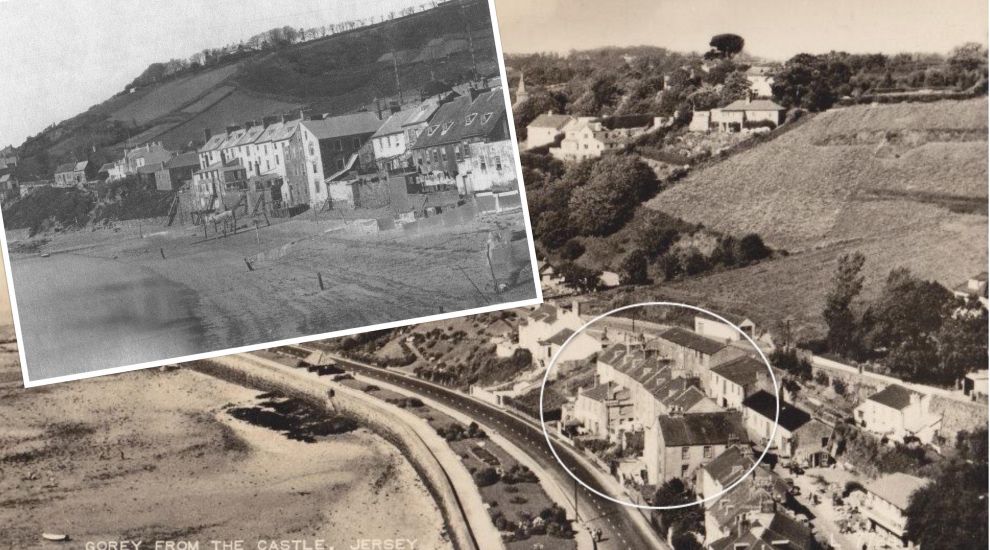


A former Bailiff, a Minister, the head of the Law Society, the chair of the States Complaints Board, and two men who were fined around £50,000 between them have lined up to slam the Government’s foreshore policy in evidence for an official review into its fairness.
More than 400 properties are affected by the policy, which sees owners of coastal homes forced to pay ‘compensation’ to the Government if their properties are deemed to encroach on the foreshore, which is defined as the zone between the high and low tide marks.
The land – no map of which has ever been made publicly available – belonged to the Queen, who had never charged for encroachments, until 2015.
Express revealed in 2017 that, after that point, the Government began to pursue those who were selling their homes, for payment – even if the encroachments pre-dated their ownership, and had been officially agreed.
For Alan Luce, who was fined £30,000 and nearly lost the sale of his Greve d’Azette home, the stress caused by the process led him to leave the island.
After heavy criticism of the policy, and a critical report from the States Complaints Board on the case of Mr Luce and Julian Mallinson, the Infrastructure Minister earlier this year published a revised policy, featuring a ‘sliding scale’ of charges relating to the nature of the encroachment and how long it has been there.

Pictured: The 'Foreshore' is vaguely defined as the land between the high and low tide marks - but historic images show how difficult that is to define.
But, for many, the revised policy does little to answer concerns. A Scrutiny Review chaired by St. Brelade Constable Mike Jackson opened earlier this year to examine the fairness of the policy.
International Development Minister Grouville Deputy Carolyn Labey, who has been fighting to correct the policy she once described as “stand and deliver”, gave evidence before the panel last week.
She described the new policy as “complex and difficult” and asked why the foreshore map – known as the ‘Master Schedule’ – hadn’t been published.
“How is that open and transparent? It then talks about default boundary but nobody knows where that is. It refuses to publish a map even a map that the applicants, who are about to sell their property, are going from to sell. I see the new policy as not the way forward.”
Deputy Labey also shared photo evidence of the high tide reaching as far as the Royal Yacht Hotel, leading her to ask whether the Government ought to take responsibility for the encroachments it has placed on the foreshore or whether Ports of Jersey should be fined?

Pictured: Deputy Labey had photos of the the high tide stretching all the way to the Royal Yacht Hotel - proof, she suggested, that the Government itself had encroached through its land reclamation.
She added that she would be seeking to make an amendment to the Minister’s policy, which former Bailiff and External Relations Minister Sir Philip Bailhache was assisting her with.
He appeared alongside her at the hearing, during which he likened the Government’s approach to the foreshore as that of a “commercial property developer” – the likely result, he said, of Jersey Property Holdings’ mandate when the body was set up to extract the optimum benefit from property assets.”
“When one looks at the face of those words one can well understand that JPH might think that their duty is to extract from landowners who may or may not have encroached upon the foreshore the maximum amount of money that they can. I do not think that that is the proper approach,” he argued.
Law Society CEO Neville Benbow told the panel in a letter that those in the legal profession were “still at a loss to understand how the Public actually benefits in real terms from the aggressive approach taken.”
Mr Benbow added that it was a “big assumption that sea walls were always built above the high water mark and on Crown-owned land”, questioning whether some coastal properties might in fact be on historic land owned by Seigneurs of the island.
He went on to blast the decision not to release the Master Schedule, particularly given that much of the information it is based upon is in the public domain.
“It does not sit well that the Minister/JPH (allegedly on behalf of Le Public de cette Ile) is pronouncing the 'real truth' as to the extent of the foreshore. It was not so defined in the contract by which the Public acquired it from the Crown, and it is wrong that owners of land adjoining the foreshore are unable to review, agree with or reject the assertions being made by the Minister/JPH,” Mr Benbow explained.
The States of Jersey Complaints Board, which upheld the complaint of unfairness by Mr Luce and Mr Mallinson, made the point that the Infrastructure Minister stated that the use of the term “Public de cette Ile” was an interchangeable expression meaning the Government of the island during a hearing with them.

Pictured: Deputy Kevin Lewis, Minister for Infrastructure, with responsibility for Jersey Property Holdings.
Its Chair, Geoffery Crill, explained: “The Board does not accept that position. The Board considers that the “Public” is wider than the government, and is more the trustee of the people of the Island as a whole, both present and future. As such, it may have a broader, more protective and benign responsibility than the government.
“That being the case, it can sacrifice some monetary value for a wider community benefit if the circumstances are appropriate. It is suggested that the benefit to the Public of having the boundaries of its property defined clearly, and likewise the wider property-owning public being able to identify the limits of its private property justify a benign approach (as had been adopted by the Crown before its transfer of the foreshore to the Island). It should be stressed at this point that we are referring here only to the mutual benefit to both landowners of clarifying their common boundary, and not to the added value of any building or other encroachments.)”
He went on to raise issues with the fact that, even in instances where homeowners had paid, they weren’t left with any certainty as to the long-term future of whether their encroachments would be able to remain.
“The complainants got very little for their money. If the Public is going to demand large sums for permitting encroaching buildings to remain, then that right to remain should be clear and absolute.”
Mr Mallinson, who was fined around £20,000 for some steps leading from his property to the beach for which he received planning permission, proposed a way forward in his letter to Scrutiny. He said he believed there should be no fines relating to encroachments pre-dating the gift of the foreshore.

Pictured: Julian Mallinson had the Crown's permission to put some steps leading to the beach in place.
“For any encroachments that were created after the Government’s ownership, the Government will have the right to ask for their removal or request a fair price for their benefit to the landowner, each case to be judged on its own merit, having regard to factors such as planning consent and the extent of the encroachment,” he suggested.
Sharing his personal experience of attempting to resolve the boundary issue as he tried to sell his home in a letter, Mr Luce recalled being told by someone assisting with the transaction that they would rather “deal with… gangsters”.
He explained the pressure the saga placed on his health, explaining how it had contributed to stress and wellbeing issues he was still living with now.
“My overwhelming hope is that others do not suffer the same struggle, that pragmatism ultimately prevails, that the JPH admit a failing in judgement, scoping and execution,” he said.
Pictured top: Alan Luce, Sir Philip Bailhache, Deputy Carolyn Labey, and Julian Mallinson.
Comments
Comments on this story express the views of the commentator only, not Bailiwick Publishing. We are unable to guarantee the accuracy of any of those comments.